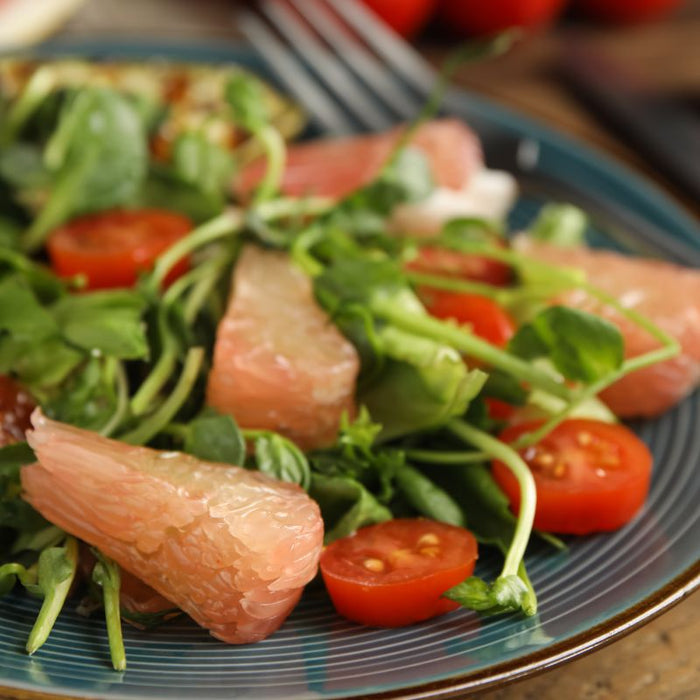
Pink Pomelo - 1pc
by Foodcraft
Original price
HK$0
Original price
HK$99.00
-
Original price
HK$99.00
Original price
Current price
HK$99.00
HK$99.00
-
HK$99.00
Current price
HK$99.00
A pink pomelo is a citrus fruit that belongs to the Rutaceae family.
It is the largest of all citrus fruits, known for its distinctive pink or pinkish-reddish flesh and yellow to light green rind.
The pomelo is native to Southeast Asia and is cultivated in various tropical and subtropical regions around the world.
The pink pomelo has a thick peel that is usually easy to remove, revealing segments of juicy, slightly sweet, and mildly tangy flesh.
The flavor is similar to that of grapefruit but milder and less bitter.
The texture can vary from firm to slightly tender, depending on the ripeness.
Pink pomelos are often enjoyed fresh as a refreshing snack or used in various culinary applications.
The segments can be eaten on their own, added to fruit salads for a burst of citrus flavor, or incorporated into desserts, smoothies, and cocktails.
The zest and juice of pink pomelo can also be used in cooking and baking to impart a unique citrusy aroma and taste.
Aside from being delicious, pink pomelos are rich in nutrients. They are a good source of vitamin C, dietary fiber, and antioxidants, which contribute to overall health and well-being.
It is the largest of all citrus fruits, known for its distinctive pink or pinkish-reddish flesh and yellow to light green rind.
The pomelo is native to Southeast Asia and is cultivated in various tropical and subtropical regions around the world.
The pink pomelo has a thick peel that is usually easy to remove, revealing segments of juicy, slightly sweet, and mildly tangy flesh.
The flavor is similar to that of grapefruit but milder and less bitter.
The texture can vary from firm to slightly tender, depending on the ripeness.
Pink pomelos are often enjoyed fresh as a refreshing snack or used in various culinary applications.
The segments can be eaten on their own, added to fruit salads for a burst of citrus flavor, or incorporated into desserts, smoothies, and cocktails.
The zest and juice of pink pomelo can also be used in cooking and baking to impart a unique citrusy aroma and taste.
Aside from being delicious, pink pomelos are rich in nutrients. They are a good source of vitamin C, dietary fiber, and antioxidants, which contribute to overall health and well-being.
How to eat pink pomelo?
Eating a pink pomelo is a delightful experience. Here's how you can enjoy this citrus fruit:
1. Peel the pomelo: Start by cutting off the top and bottom of the fruit, just enough to expose the flesh. Then, make shallow cuts along the sides of the fruit, following the curve of the fruit from top to bottom. Gently remove the thick rind, peeling it away in sections, and discard it.
2. Separate the segments: Once the pomelo is peeled, you'll see the individual segments separated by pith. Carefully remove the segments by hand or use a knife to gently cut along the membranes to release the juicy segments. Remove any seeds if present.
3. Enjoy the segments: The pink pomelo segments can be eaten as they are, either by directly biting into them or using a fork. They have a sweet and tangy flavor that is less bitter than grapefruit. Take a bite and savor the refreshing taste.
4. Use in salads: Pink pomelo segments can be added to fruit salads or green salads for a burst of citrus flavor. Combine them with other fruits like strawberries, oranges, or kiwi, or mix them with salad greens, nuts, and a vinaigrette dressing for a refreshing salad.
5. Blend into drinks: Pink pomelo juice can be used to make refreshing beverages. Squeeze the juice from the segments and mix it with water, sparkling water, or even in cocktails. You can also blend the segments with ice and a sweetener of your choice for a homemade pink pomelo slushie.
6. Incorporate into desserts: Pink pomelo segments can be used as a topping for desserts like yogurt, ice cream, or custard. They can also be used in cakes, tarts, or fruit-based desserts for a tangy and citrusy twist.
Remember to remove any tough pith or seeds before consuming. Experiment with different ways to enjoy pink pomelo, and let your taste preferences guide you. Enjoy the unique flavor and refreshing qualities of this citrus fruit in various culinary creations.
Is pink pomelo low FODMAP?
Pink pomelo is considered low FODMAP in moderate servings according to Monash University, a leading authority on the low FODMAP diet. The recommended serving size is up to ½ a cup or approximately 78 grams of pomelo flesh per sitting.
The FODMAP content in pomelo primarily comes from oligosaccharides called fructans. Fructans can be difficult to digest for some individuals with irritable bowel syndrome (IBS) or other digestive disorders. However, the fructan content in pink pomelo is relatively low, making it suitable for those following a low FODMAP diet, as long as the recommended serving size is adhered to.
It's important to note that individual tolerance to FODMAPs can vary, and some people with IBS may still experience symptoms even with low FODMAP foods. If you have concerns or specific dietary needs, it's best to consult with a registered dietitian who specializes in the low FODMAP diet. They can provide personalized guidance and help you determine your specific tolerances and dietary requirements.
Eating a pink pomelo is a delightful experience. Here's how you can enjoy this citrus fruit:
1. Peel the pomelo: Start by cutting off the top and bottom of the fruit, just enough to expose the flesh. Then, make shallow cuts along the sides of the fruit, following the curve of the fruit from top to bottom. Gently remove the thick rind, peeling it away in sections, and discard it.
2. Separate the segments: Once the pomelo is peeled, you'll see the individual segments separated by pith. Carefully remove the segments by hand or use a knife to gently cut along the membranes to release the juicy segments. Remove any seeds if present.
3. Enjoy the segments: The pink pomelo segments can be eaten as they are, either by directly biting into them or using a fork. They have a sweet and tangy flavor that is less bitter than grapefruit. Take a bite and savor the refreshing taste.
4. Use in salads: Pink pomelo segments can be added to fruit salads or green salads for a burst of citrus flavor. Combine them with other fruits like strawberries, oranges, or kiwi, or mix them with salad greens, nuts, and a vinaigrette dressing for a refreshing salad.
5. Blend into drinks: Pink pomelo juice can be used to make refreshing beverages. Squeeze the juice from the segments and mix it with water, sparkling water, or even in cocktails. You can also blend the segments with ice and a sweetener of your choice for a homemade pink pomelo slushie.
6. Incorporate into desserts: Pink pomelo segments can be used as a topping for desserts like yogurt, ice cream, or custard. They can also be used in cakes, tarts, or fruit-based desserts for a tangy and citrusy twist.
Remember to remove any tough pith or seeds before consuming. Experiment with different ways to enjoy pink pomelo, and let your taste preferences guide you. Enjoy the unique flavor and refreshing qualities of this citrus fruit in various culinary creations.
Is pink pomelo low FODMAP?
Pink pomelo is considered low FODMAP in moderate servings according to Monash University, a leading authority on the low FODMAP diet. The recommended serving size is up to ½ a cup or approximately 78 grams of pomelo flesh per sitting.
The FODMAP content in pomelo primarily comes from oligosaccharides called fructans. Fructans can be difficult to digest for some individuals with irritable bowel syndrome (IBS) or other digestive disorders. However, the fructan content in pink pomelo is relatively low, making it suitable for those following a low FODMAP diet, as long as the recommended serving size is adhered to.
It's important to note that individual tolerance to FODMAPs can vary, and some people with IBS may still experience symptoms even with low FODMAP foods. If you have concerns or specific dietary needs, it's best to consult with a registered dietitian who specializes in the low FODMAP diet. They can provide personalized guidance and help you determine your specific tolerances and dietary requirements.














